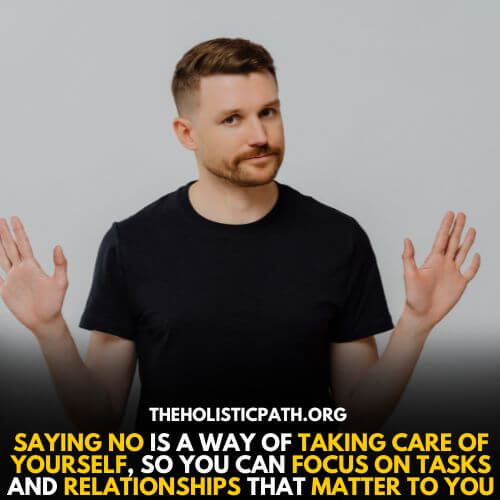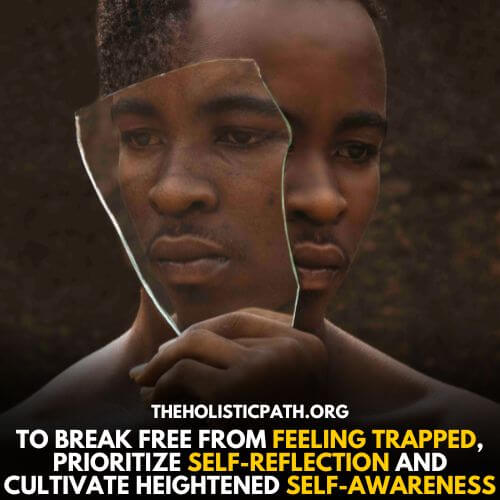Feeling trapped is a tough spot to be in – whether it’s in the complexities of a relationship, the grind of a job, or just the tangled mess that life can sometimes become. The struggle is real, and it’s okay to feel lost. But guess what?
You can break free without losing yourself in the process.
We’ve all hit those moments where everything seems to close in, making us wonder if there’s a way out. Here’s the deal: feeling trapped is common, and there are ways to tackle it. In this journey, we’ll explore some practical solutions to help you navigate through the maze and regain a sense of freedom.
Psychology of Feeling Trapped: What Does It Feel Like?
Feeling trapped is more than just a tough moment; it involves a mix of emotions, thoughts, and external factors that create a sense of confinement. Let’s break it down:
-
Internal Struggles: This includes things like self-doubt, fear, or that feeling of being powerless, all brewing inside your mind.
-
External Pressures: Life can throw curveballs, be it societal expectations, challenging circumstances, or unsatisfying relationships, contributing to that trapped sensation.
-
Cognitive Patterns: Your way of thinking matters. Past experiences and coping mechanisms influence how you perceive and handle feeling trapped.
Moreover, the experience of feeling trapped can manifest as:
-
Indecisiveness: A sense of being unable to make decisions, adding to the feeling of being stuck.
-
Paralyzed by Fear: Fear becomes a dominating force, hindering the ability to take necessary steps forward.
-
Negative Thoughts: The mind is filled with pessimistic and limiting thoughts, contributing to a sense of hopelessness.
-
Lack of Control: The perception of not having control over one’s life, with external factors like finances, employment, or relationships acting as constraining forces.
17 Ways to Escape Feeling Trapped
Feeling trapped in life can be a challenging and overwhelming experience, affecting your mental well-being and overall happiness. However, the journey towards overcoming this sense of feeling trapped is entirely possible through self-improvement and proactive steps. Here are a few things that you can try:
1. Self-Reflection and Awareness:
Feeling trapped often stems from a lack of understanding about our own desires and frustrations. To break free, prioritize self-reflection and cultivate heightened self-awareness. Through practices like journaling, mindfulness, and seeking feedback, you can identify the sources of entrapment and lay the foundation for meaningful change.
How to Implement:
- Journaling: Regularly write down your thoughts and emotions.
- Mindfulness Practices: Engage in activities like meditation to increase self-awareness.
- Seeking Feedback: Reach out to trusted friends or mentors for insights.
2. Set Clear Goals:
Escaping the feeling of being trapped requires a roadmap for personal and professional growth. Establishing clear and realistic goals provides direction and purpose. Employ the SMART criteria—Specific, Measurable, Achievable, Relevant, and Time-bound—and break down larger objectives into manageable tasks, fostering a sense of accomplishment.
How to Implement:
- Utilize SMART Goals: Ensure your goals are Specific, Measurable, Achievable, Relevant, and Time-bound.
- Create Action Plans: Outline the steps needed to reach your objectives.
- Regular Progress Assessment: Periodically review your goals and adjust them as needed.
3. Cultivate Self-Love:
Escape from the feeling of entrapment involves fostering a positive relationship with oneself. Cultivating self-love means recognizing your worth and practicing self-compassion. Embrace your strengths, acknowledge achievements, and treat yourself with the same kindness you extend to others.
How to Implement:
- Positive Affirmations: Remind yourself of your strengths and accomplishments.
- Self-Care Practices: Engage in activities that promote well-being and relaxation.
- Forgive Yourself: Let go of past mistakes and embrace a mindset of self-compassion.
4. Develop a Growth Mindset:
A growth mindset is instrumental in overcoming challenges and escaping the feeling of entrapment. Embrace the belief that abilities and intelligence can be developed through dedication and hard work. By adopting a growth mindset, you open yourself to continuous learning and resilience in the face of obstacles.
How to Implement:
- Embrace challenges as opportunities for growth.
- View effort as the path to mastery.
- Learn from criticism and feedback.
5. Establish Boundaries:
Setting boundaries means deciding what’s okay and what’s not okay in different parts of your life, like relationships, work, and personal time. It’s important for taking care of your mind and emotions.
When you make it clear what’s acceptable and what’s not, you create a strong structure that helps relationships stay healthy and prevents you from feeling overwhelmed.
This is like an act of self-love because it’s a way of putting yourself first and making sure your life is balanced and satisfying. Setting boundaries is about knowing your limits, being okay with saying no when you need to, and making a space that supports your personal growth and well-being.
6. Physical Exercise:
Physical exercise is a foundational pillar for both physical and mental well-being. It involves any bodily activity that enhances or maintains physical fitness and overall health. Engaging in regular exercise brings a myriad of benefits, including improved cardiovascular health, increased muscle strength and flexibility, and enhanced mood.
From simple activities like walking or jogging to more structured forms like gym workouts or sports, physical exercise releases endorphins—often referred to as “feel-good” hormones—contributing to a positive mindset. This practice aligns with the concept of self-improvement, promoting not only physical health but also mental resilience and emotional well-being.
Regular exercise is a powerful tool for breaking free from feelings of entrapment, providing a tangible and proactive approach to improving your overall quality of life.
7. Travel and Explore:
Traveling and exploring encompass the act of venturing beyond your usual environment to discover new places, cultures, and experiences. This practice offers a unique opportunity for personal growth and self-discovery.
It aligns with the concept of finding happiness and escape, encouraging a fresh outlook on life and fostering a sense of wonder and discovery.
8. Build a Resilient Support System:
Building a strong support system is essential for overcoming challenges and feelings of isolation. Surrounding yourself with individuals who understand, encourage, and uplift you provides a crucial emotional safety net. Strengthen your relationships, seek guidance when needed, and reciprocate support to create a resilient support system.
How to Implement:
- Open Communication: Share your thoughts and feelings with trusted friends or family.
- Quality Over Quantity: Focus on nurturing a few meaningful relationships rather than a large network.
- Reciprocal Support: Be available to support others in your network when they need it.
9. Enhance Your Communication Skills:
Communication is a cornerstone of personal and professional success. Improving your communication skills can alleviate the feeling of entrapment by facilitating better expression of thoughts and emotions. Emphasize active listening, practice clear and concise articulation, and refine non-verbal cues to establish meaningful connections.
How to Implement:
- Active Listening: Focus on truly understanding others before responding.
- Clear Articulation: Practice expressing ideas concisely and understandably.
- Non-Verbal Cues: Pay attention to body language and facial expressions during interactions.
10. Create a Vision Board:
Creating a vision board is a creative and visual representation of your goals, aspirations, and desires. It involves compiling images, quotes, and symbols onto a board that resonates with the life you envision.
This intentional and artistic practice aligns with the principles of self-love and a growth mindset.
By externalizing your dreams through the vision board, you create a tangible reminder of your aspirations. This can serve as a daily source of inspiration, redirecting your focus from feeling trapped to actively visualizing and working towards a future filled with purpose and achievement.
11. Explore New Hobbies:
Breaking free from the monotony of a trapped feeling often involves injecting freshness into your routine. Exploring new hobbies not only provides an avenue for personal enjoyment but also expands your horizons and introduces you to diverse perspectives.
Whether it’s art, sports, or intellectual pursuits, discovering a passion can rekindle a sense of purpose.
How to Implement:
- Try Diverse Activities: Experiment with a range of hobbies to find what resonates with you.
- Commit to Learning: Embrace the learning process and stay open to new experiences.
- Connect with Communities: Join clubs or groups related to your chosen hobbies for added social engagement.
12. Express Yourself Creatively:
Getting creative is all about finding fun ways to show the world who you are! Whether it’s writing, drawing, painting, making music, dancing, or anything that lets you be artsy, it’s like your special superpower.
Being creative is awesome because it helps you share your feelings, thoughts, and experiences in a cool and unique way.
It’s not just about having fun; it’s also about discovering new things about yourself and getting better at what you enjoy. So, when you get creative, you’re not just making something cool; you’re opening doors to break free from feeling trapped. It’s a way to grow personally and have a happy outlet for your feelings!

13. Learn to Say No:
Learning to say no is like having a superpower that helps you set limits on your time, energy, and the things you commit to. It’s about understanding how much you can handle without overwhelming yourself.
Saying no is a way of taking care of yourself, so you can focus on tasks and relationships that matter to you.
This is all about creating a balance that aligns with your goals and well-being, kind of like drawing a protective circle around your mental and emotional space. When you get good at saying no, you’re not just saying it to tasks; you’re saying yes to personal growth, a better work-life balance, and avoiding the feeling of being stuck with too many obligations.
14. Celebrate Small Wins:
Celebrating small wins is like giving yourself a high-five for the little achievements on your journey, even if they seem tiny. It’s a way to make your mind happy and feel proud.
This cool practice helps you keep a positive attitude and makes you feel like you’re getting things done.
Instead of just looking at the big picture, it’s like zooming in on the small steps you’ve taken and saying, “Hey, I did that!” Celebrating these small victories is like filling up your motivation tank, boosting your confidence, and making your personal growth journey feel exciting and optimistic.
15. Embrace Change:
Embracing change is like having a superpower for personal growth, helping you escape that feeling of being stuck. Change is like a friend that brings chances for you to become even better. This means being open to new experiences, and challenges, and seeing things from different angles.
When you embrace change, it’s like saying yes to all the exciting possibilities out there.
You break free from feeling trapped, becoming more adaptable to whatever comes your way. Think of it as having a mindset that loves to learn and grow, making your life more interesting and full of possibilities.
16. Create a Purposeful Daily Plan:
17. Seek Professional Guidance:
ADHD Feeling Trapped: 10 Easy Solutions
Individuals with Attention Deficit Hyperactivity Disorder (ADHD) may experience a unique sense of feeling trapped or paralyzed, often associated with challenges in attention, focus, and impulse control. The feeling of paralysis in the context of ADHD can manifest in several ways, hindering one’s ability to initiate or sustain tasks. Here’s a breakdown:
Living with Attention Deficit Hyperactivity Disorder (ADHD) often brings a sense of feeling trapped or paralyzed, stemming from challenges in initiating tasks and maintaining focus. To address this, here are 10 practical strategies:
-
Break Tasks Down: Divide tasks into smaller steps to make them more manageable and reduce overwhelm.
-
Visual Tools: Use charts and to-do lists for visual organization and task prioritization.
-
Realistic Goals: Set achievable goals to build confidence and alleviate the sense of being trapped.
-
Establish a Routine: Create a daily routine for structure, helping navigate responsibilities more efficiently.
-
External Reminders: Use alarms and apps to assist with time management and task tracking.
-
Mindfulness Techniques: Practice mindfulness and relaxation to manage stress and approach tasks with focus.
-
Build a Support System: Communicate challenges with friends, family, or colleagues for understanding and encouragement.
-
Clear Priorities: Prioritize tasks based on importance to prevent feeling overwhelmed.
-
Breaks and Rewards: Incorporate breaks and rewards to make tasks more enjoyable and positive.
-
Professional Guidance: Seek support from mental health professionals for tailored strategies and coping mechanisms.
Feeling Trapped in My Job: 7 Things You Can Do
Experiencing a sense of being trapped in your job can be challenging, but there are 7 actionable steps you can take to address this feeling:
-
Assess Your Situation: Evaluate why you feel trapped. Identify specific challenges or aspects of your job causing dissatisfaction.
-
Communicate with Your Supervisor: Discuss your concerns with your supervisor. Open communication can lead to solutions or a better understanding of your situation.
-
Explore Internal Opportunities: Look for growth opportunities within your current workplace. Internal job changes may offer a fresh start.
-
Skill Development: Invest in developing new skills that can enhance your job satisfaction and make you more marketable.
-
Network: Connect with colleagues and professionals in your field. Networking may open doors to new opportunities outside your current job.
-
Seek Professional Advice: Consult with career advisors or mentors for guidance on navigating your career challenges.
-
Consider a Change: If all else fails, consider exploring new job opportunities. Sometimes a change in environment can lead to increased job satisfaction.
Remember that feeling trapped in your job is a common challenge, and there are often multiple paths to finding greater job satisfaction and fulfillment. It’s essential to take proactive steps toward a solution that aligns with your long-term career goals and personal well-being.
Conclusion
You may feel like you’re stuck in a rut, but it’s important to remember that you have the power to change your life for the better. No matter how difficult your circumstances may seem, you always have the choice to persevere and fight for what you want.
The first step is to identify the things that make you feel trapped. Once you know what your barriers are, you can start to chip away at them one by one. It won’t be easy, but it will be worth it. So don’t give up – keep moving forward, and eventually, you’ll reach the life you’ve always wanted.
References:
Daily News (October 28, 2022). Global study finds 78% of people feel “stuck” professionally, and personally. https://www.dailynews.lk/2021/10/28/business/263036/global-study-finds-78-people-feel-%E2%80%9Cstuck%E2%80%9D-professionally-personally
The Gerontologist, Volume 58, Issue 1 (17 February 2017). “I Feel Trapped”: The Tension Between Personal and Structural Factors of Social Isolation and the Desire for Social Integration Among Older Residents of a High-Crime Neighborhood. https://academic.oup.com/gerontologist/article/58/1/79/3001859


